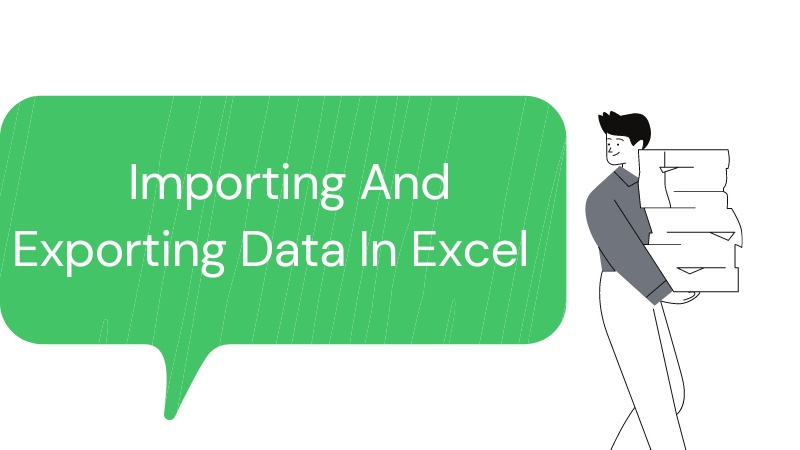Introduction
Importing and exporting data in Excel is a common requirement for many users, allowing them to transfer data between different sources, systems, or formats. Excel provides several methods and tools to import data into a worksheet and export data from Excel to other file formats. In this guide, we will explore various techniques for importing and exporting data in Excel.
We always provide premium quality solutions as they are always error-free, 100% unique, easy to understand, and absolutely original. This helps the students to get good grades in academics and improve their knowledge about Excel topics. So, if you want to get Importing And Exporting Data In Excel and Excel assignments help for beginners or advanced levels, then you can contact us anytime! We are always ready to help you 24/7 to solve your assignment in Excel.
Importing Data into Excel:
- Opening External Files:
- Excel allows you to directly open external files, such as CSV (Comma-Separated Values), TXT (Plain Text), or XML (eXtensible Markup Language) files. To open a file, go to the "File" tab, click on "Open," and select the desired file. Excel will automatically import the data into a new or existing worksheet.
- Copying and Pasting:
- You can copy data from external sources, such as websites, databases, or other Excel files, and paste it directly into an Excel worksheet. Select the source data, press Ctrl + C to copy, navigate to Excel, select the destination cell, and press Ctrl + V to paste the data. Excel will retain the original formatting and structure of the copied data.
- Importing Text Files:
- Excel provides a Text Import Wizard that allows you to import structured or delimited text files. To import a text file, go to the "Data" tab, click on "Get External Data," and choose "From Text." Follow the steps in the Text Import Wizard to specify the file type, delimiter, and other settings. Excel will import the text file into a worksheet, with each data field separated into columns.
- Connecting to External Data Sources: Excel supports connecting to various external data sources, including databases, web services, and online data repositories. To connect to an external data source, go to the "Data" tab, click on "Get External Data," and choose the appropriate data source option. Follow the steps in the data connection wizard to establish the connection and import the data into Excel.
Exporting Data from Excel:
- Saving as Different File Formats:
- Excel allows you to save a workbook in different file formats, making it easy to export data to formats like CSV, TXT, PDF, or HTML. To save a workbook as a different file format, go to the "File" tab, click on "Save As," and select the desired file format from the available options. Specify the file name, location, and additional settings, if applicable, and save the file.
- Exporting as PDF:
- Excel provides the option to directly export a worksheet or an entire workbook as a PDF file. This is useful for sharing data in a non-editable format or for printing purposes. To export as PDF, go to the "File" tab, click on "Save As," choose the PDF file format, specify the file name and location, and save the PDF.
- Using Save As CSV:
- To export data as a CSV file, go to the "File" tab, click on "Save As," select the CSV file format, specify the file name and location, and save the CSV file. Excel will prompt you to confirm the file format and may ask you to choose additional settings, such as the delimiter character.
- Publishing to Web or SharePoint:
- Excel allows you to publish a worksheet or an entire workbook to the web or a SharePoint site. This makes it accessible to others through a web browser, without requiring them to have Excel installed. To publish to the web or SharePoint, go to the "File" tab, click on "Save As," choose the "Web Page" or "SharePoint" option, specify the desired settings, and publish the file.
- Using Power Query:
- Power Query is a powerful data transformation and connectivity tool in Excel that can be used to import and export data from various sources. It provides advanced capabilities to connect, transform, and load data from different sources and file formats. Power Query allows for complex data manipulation, filtering, merging, and cleaning before exporting the data to Excel or other file formats.
- Copying and Pasting:
- Similar to importing data, you can also export data from Excel by copying and pasting it into other applications or systems. Select the range of data in Excel, press Ctrl + C to copy, navigate to the destination application, and press Ctrl + V to paste the data. Excel will retain the formatting and structure of the copied data.
Conclusion
Excel's import and export capabilities provide flexibility and convenience for managing data in different formats and sources. Whether it's importing data from external files or databases, connecting to external data sources, or exporting data to various file formats, Excel offers a range of options to meet your data integration and sharing needs.


No comments yet